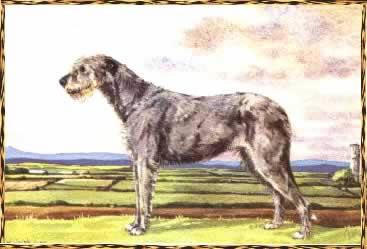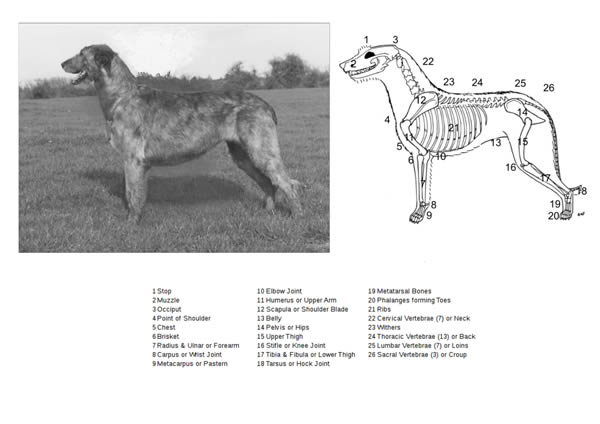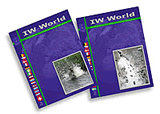Standard of the Irish Wolfhound
›› FCI - IRISH WOLFHOUND Standard
No. 160, 02.04.2001 (pdf)
( » New revised standard - English - 03.08.2015 )
( » New revised standard - German)

›› FCI - IRISH WOLFHOUND Standard
No. 160, 02.04.2001 (pdf)
The I.K.C standard for this breed includes an addendum (List of Points in Order of Merit)
which may not be included by the F.C.I.
COUNTRY OF ORIGIN: Ireland.
DATE OF PUBLICATION OF THE ORIGINAL VALID STANDARD: 13.03.2001.
UTILIZATION: Up to the end of the17th century, Irish Wolfhounds were used for hunting wolves and deer in Ireland. They were also used for hunting the wolves that infested large areas of Europe before the forests were cleared.
CLASSIFICATION FCI: Group 10 (sighthounds) Section 2 (rough-coated sighthounds) Without working trial.
CLASSIFICATION IRELAND: Hound Group.
BRIEF HISTORICAL SUMMARY: We know the continental Celts kept a greyhound probably descended from the greyhound first depicted in Egyptian paintings. Like their continental cousins, the Irish Celts were interested in breeding large hounds. These large Irish hounds could have had smooth or rough coats, but in later times, the rough coat predominated possibly because of the Irish climate. The first written account of these dogs was by a Roman Consul 391 A.D. but they were already established in Ireland in the first century A.D. when Setanta changed his name to Cu-Chulainn (the hound of Culann). Mention is made of the Uisneach (1st century) taking 150 hounds with them in their flight to Scotland. Irish hounds undoubtedly formed the basis of the Scottish Deerhound. Pairs of Irish hounds were prized as gifts by the Royal houses of Europe, Scandinavia and elsewhere from the Middle ages to the 17th century. They were sent to England, Spain, France, Sweden, Denmark, Persia, India and Poland. In the15th century each county in Ireland was required to keep 24 wolfdogs to protect farmers' flocks from the ravages of wolves. The Cromwellian prohibition (1652) on the export of Wolfhounds helped preserve their number for a time but the gradual disappearance of the wolf and continued demand abroad reduced their numbers almost to the point of extinction by the end of the 17th century. The revival of interest in the breed accompanied the growth of Irish nationalism in the late 19th century. The Irish Wolfhound became a living symbol of Irish culture and of the Celtic past. At this time, one determined enthusiast, Capt. G A Graham, set about obtaining some of the few remaining hounds of the Wolfhound type that could still be found in Ireland, and with the use of Deerhound blood and the occasional outcross of Borzoi and Great Dane, he eventually achieved a type of dog that bred true in every generation. The results were ultimately accepted as a legitimate revival of the breed. The Irish Kennel Club scheduled a class for Irish Wolfhounds at their show in April 1879, and a club was formed in 1885. The Irish Wolfhound now enjoys once again something of the reputation that it had in the Middle Ages. Wolfhounds are now owned and bred in fairly large numbers outside of Ireland.
GENERAL APPEARANCE: The Irish Wolfhound should not be quite so heavy or massive as the Great Dane, but more so than the Deerhound, which in general type he should otherwise resemble. Of great size and commanding appearance, very muscular, strongly though gracefully built, movements easy and active; head and neck carried high; the tail carried with an upward sweep with a slight curve towards the extremity. Great size, including height at shoulder and proportionate length of body, is the desideratum to be aimed at, and it is desired to firmly establish a race (that shall average 32 inches (81cm) to 34 inches (86cm) in dogs) showing the requisite power, activity, courage and symmetry.
BEHAVIOUR AND TEMPERAMENT: «Lambs at home, lions in the chase».
PHYSICAL CHARACTERISTICS:
HEAD: Long and level, carried high; the frontal bones of the forehead very slightly raised and very little indentation between the eyes.
CRANIAL REGION:
Skull: Not too broad
FACIAL REGION:
• Muzzle: Long and moderately pointed.
• Teeth: Scissor bite ideal, level acceptable.
• Eyes: Dark.
• Ears: Small Rose Ears (Greyhound like in carriage).
NECK: Rather long, very strong and muscular, well arched, without dewlap or loose skin about the throat.
BODY: Long, well ribbed up.
• Back: Rather long than short.
• Loins: Slightly arched.
• Croup: Great breadth across hips.
• Chest: Very deep, moderately broad, breast wide.
• Ribs : Well sprung.
• Belly: Well drawn up.
TAIL: Long and slightly curved, of moderate thickness, and well covered with hair.
LIMBS:
FOREQUARTERS:
• Shoulders: Muscular, giving breadth of chest, set sloping.
• Elbows: Well under, neither turned inwards nor outwards.
• Forearm: Muscular, heavily boned, quite straight.
HINDQUARTERS:
• Thighs: Long and muscular.
• Stifle: Nicely bent.
• Second thigh: Well muscled, long and strong.
• Hocks: Well let down and turning neither in nor out.
FEET: Moderately large and round, neither turned inward nor outwards.
• Toes: Well arched and closed.
• Nails: Very strong and curved.
GAIT / MOVEMENT: Movements easy and active.
COAT:
HAIR: Rough and hard on body, legs and head; especially wiry. Hair over eyes and beard especially wiry.
COLOUR AND MARKINGS:
The recognised colours are grey, brindle, red, black, pure white, fawn or any colour that appears in the Deerhound.
SIZE: (Height & Weight)
• Desired height: averaging 32 inches (81cm) to 34 inches (86cm) in dogs.
• Minimum height: Dogs 31 inches (79 cm).
• Minimum weight: Dogs 120 pounds (54,5 kg).
• Minimum height: Bitches 28 inches (71 cm).
• Minimum weight: Bitches 90 pounds (40.5 kg).
FAULTS:
Any departure from the foregoing points should be considered a fault and the seriousness with which the fault should be regarded should be in exact proportion to its degree.
• Too light or too heavy a head.
• Too highly arched frontal bone.
• Crooked forelegs, weak pasterns.
• Weak hindquarters and a general want of muscle.
• Too short in body.
• Back sunken or hollow or quite straight.
• Large ears and hanging flat to the face.
• Twisted feet.
• Spreading toes.
• Short neck; full dewlap.
• Chest too narrow or too broad.
• Tail excessively curled.
• Nose of any colour other than black.
• Lips of any colour other than black.
• Very light eyes. Pink or liver coloured eyelids.
DISQUALIFYING FAULTS:
• Aggressive or overly shy dogs.
• Any dog clearly showing physical of behavioural abnormalities shall be disqualified
NOTE:
• Male animals should have two apparently normal testicles fully descended into the scrotum.
• Only functionally and clinically healthy dogs, with breed typical conformation should be used for breeding.

Click on the picture to enlarge


New revised standard - 03.08.2015
» Congress EIWC 2016 - Meeting
» Addendum nr 1. (1. President’s address)
• New revised standard - Introduction
• New revised standard
Revised Standard of The Irish Wolfhound
Update from Irish Wolfhound Club of Ireland
February, 2017
GAIT / MOVEMENT: Movements easy and active with good reach and drive.
Regarding the wording on movement in the Revised Standard, you will remember that we suggested adding the words with good reach and drive.
In view of the appearance in Facebook recently of some photographs showing Irish Wolfhounds moving with faulty over extended action we have decided to withdraw the words
«with good reach and drive».
Jim Behan & Betty Murphy.
COUNTRY OF ORIGIN: Ireland.
DATE OF PUBLICATION OF THE ORIGINAL VALID STANDARD: 13.03.2001.
UTILIZATION: Up to the end of the17th century, Irish Wolfhounds were used for hunting wolves and deer in Ireland.
CLASSIFICATION FCI: Group 10 (sighthounds) Section 2 (rough-coated sighthounds) Without working trial.
BRIEF HISTORICAL SUMMARY: We know the continental Celts kept a greyhound probably descended from the greyhound first depicted in Egyptian paintings. Like their continental cousins, the Irish Celts were interested in breeding large hounds. These large Irish hounds could have had smooth or rough coats, but in later times, the rough coat predominated possibly because of the Irish climate. The first written account of these dogs was by a Roman Consul 391 A.D. They were already established in Ireland in the first century A.D. when Setanta changed his name to Cu-Chulainn (the hound of Culann). Mention is made of the Uisneach (1st century) taking 150 hounds with them in their flight to Scotland. Irish hounds undoubtedly formed the basis of the Scottish Deerhound.
In the 15th century each county in Ireland was required to keep 24 wolfdogs to protect farmers flocks from the ravages of wolves. Pairs of Irish hounds were prized as gifts from the middle ages onwards. They were sent to the Royal Houses of, amongst others, England, Spain, France, Sweden, Denmark, Persia, India and Poland.
The Cromwellian prohibition (1652) on the export of Wolfhounds helped preserve their number for a time but the gradual disappearance of the wolf and continued demand abroad reduced their numbers almost to the point of extinction by the end of the 17th century. The revival of interest in the breed accompanied the growth of Irish nationalism in the late 19th century as the Irish Wolfhound became a living symbol of Irish culture and of the Celtic past.
The breed had been maintened in the early 19th Century by enthusiasts such as Capt. Richardson, Sir John Power of Kilfane, Mr. Baker of Ballytobin and Mr. Mahony of Dromore. Starting in 1862 Capt. G. A. Graham obtained some of the few remaining hounds of the Wolfhound type that could still be found in Ireland and with the use of Deerhound blood lines, the occasional outcross of Borzoi and some lines that included the progeny of the Great Dane he eventually achieved a type of dog that bred true in every generation. Grahma recorded the pedigrees in his book « Irish Wolfhound Pedigrees 1859-1906 ». In parallel to this work breeding of pure bred Wolfhounds continued both in Ireland and in the UK. Their combined efforts were accepted as a legitimate revival of the breed.
The Kennel Club in Ireland first scheduled a class for Irish Wolfhounds at their show in Dublin in April 1879 and a club was formed in 1885.
The Irish Wolfhound now enjoys once again something of the reputation that it had in the middle ages. the Irish Wolfhound is now owned and bred worldwide.
GENERAL APPEARANCE: The largest and tallest of the sight-hounds, he is a rough-coated greyhound-like breed. Of great zize and commanding appearance, verry muscular, strongly though gracefully build, movements easy and active ; head and neck proudly carried ; the tail carried with an upward sweep with a light curve toward the extremity. The tail should be carried lower than the level of the back.
Great size, including height at shoulder and proportionate lenght of body, is the desideratum to be aimed at, and it is desired to firmly establish a race that shall have a minimum of 81 cm (32 inches) in dogs, showing the requisite power, activity, courage and symmetry.
BEHAVIOUR AND TEMPERAMENT: The flower of all his race. So true, so brave - a lamb at home. A lion in the chase. (The Irish Hound of Llewelyn 1210 AD).
He is out-going and genial with other dogs and people, determined in the chase, a loyal companion.
HEAD: Long and level proudly carried ; the frontal bones of the forehead very slightly raised and very little indentation between the eyes.
CRANIAL REGION:
Skull: Not too broad
FACIAL REGION:
• Muzzle: Long and moderately pointed.
• Teeth: Scissor bite ideal, level acceptable.
• Eyes: Dark.
• Ears: Small, rose ears, set on high.
NECK: Rather long, very strong and muscular, well arched, without dewlap or loose skin about the throat.
BODY: Long, well ribbed up.
• Back: Rather long than short.
• Loins: Slightly arched.
• Croup: Great breadth across hips.
• Chest: Very deep, moderately broad, breast wide.
• Ribs : Well sprung.
• Belly: Well drawn up.
TAIL: Long and slightly curved, of moderate thickness, and well covered with hair and should be carried lower than the level of the back.
LIMBS:
FOREQUARTERS:
• Shoulders: Muscular, giving breadth of chest, set sloping.
• Elbows: Well under, neither turned inwards nor outwards.
• Forearm: Muscular, heavily boned, quite straight with slight spring of pastern.
HINDQUARTERS:
• Thighs: Long and muscular.
• Stifle: Nicely bent.
• Second thigh: Well muscled, long and strong.
• Hocks: Well let down and turning neither in nor out.
FEET: Moderately large and round, neither turned inward nor outwards.
• Toes: Well arched and closed.
• Nails: Very strong and curved.
GAIT / MOVEMENT: Movements easy and active.
COAT:
HAIR: Rough and hard on body, legs and head. Hair over eyes and beard especially wiry.
COLOUR AND MARKINGS:
The recognised colours are grey, brindle, red, black, pure white, fawn, wheaten.
SIZE: (Height & Weight)
• Desired height: ranging from 84 cm (33 inches) in dogs.
• Minimum height: Dogs 81 cm (32 inches).
• Minimum weight: Dogs 57 kg (125 Ibs).
• Minimum height: Bitches 76 cm (30 inches).
• Minimum weight: Bitches 50 kg (110 Ibs).
These apply to mature hounds.
FAULTS:
Any departure from the foregoing points should be considered a fault and the seriousness with which the fault should be regarded should be in exact proportion to its degree and its effect
upon the health and welfare of the dog.
• Too light or too heavy a head.
• Too highly arched frontal bone.
• Narrow underjaw, misplaced canine teeth.
• Crooked forelegs, weak pasterns.
• Weak hindquarters and a general want of muscle.
• Too short in body.
• Back sunken or hollow or quite straight.
• Large ears and hanging flat to the face.
• Twisted feet.
• Spreading toes.
• Short neck; full dewlap.
• Chest too narrow or too broad.
• Tail excessively curled.
• Nose of any colour other than black.
• Lips of any colour other than black.
• Very light eyes. Pink or liver coloured eyelids.
• Any signs of nervousness or aggression.
Any dog clearly showing physical or behavioural abnormalities shall be disqualified.
NOTE:
Male animals should have two apparently normal testicles fully descended into the scrotum.




